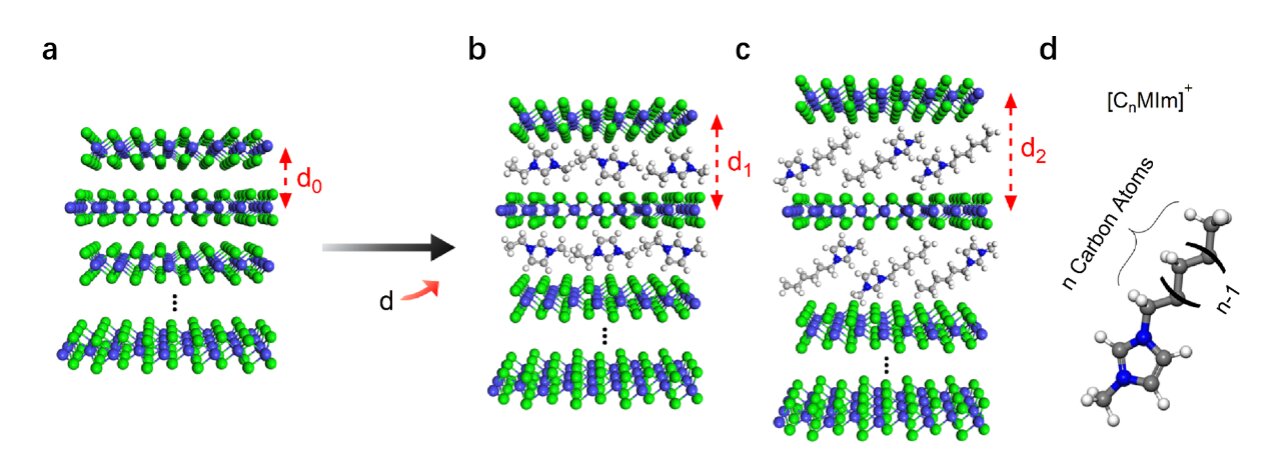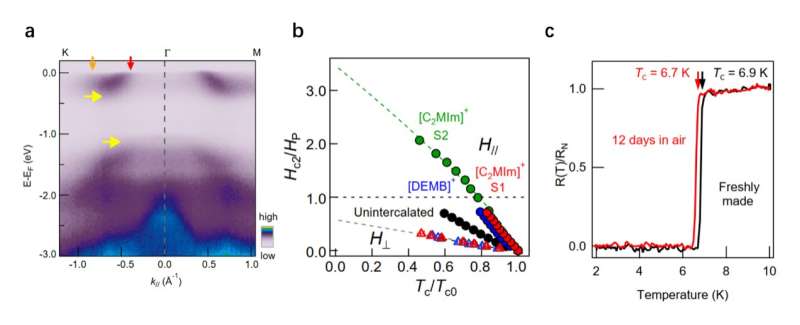
![Schematic of dimensionality manipulation of NbSe2 through ionic liquid cation intercalation. a, Atomic structure of NbSe2. b,c, Manipulating the interlayer spacing of NbSe2 by intercalating cations with different sizes, aiming at controlling the interlayer interaction. d, Atomic structure of ionic liquid cations [CnMIm]+. Credit: Zhang et al. Study demonstrates tailored Ising superconductivity in intercalated bulk niobium diselenide](https://skynews.icu/wp-content/uploads/2022/11/Study-demonstrates-tailored-Ising-superconductivity-in-intercalated-bulk-niobium-diselenide.jpg)
When 2D layered materials are made thinner (i.e., at the atomic scale), their properties can dramatically change, sometimes resulting in the emergence of entirely new features and in the loss of others. While new or emerging properties can be very advantageous for the development of new technologies, retaining some of the material’s original properties is often equally important.
Researchers at Tsinghua University, the Chinese Academy of Sciences and the Frontier Science Center for Quantum Information have recently been able to realize tailored Ising superconductivity in a sample of intercalated bulk niobium diselenide (NbSe2), a characteristic of bulk NbSe2 that is typically compromised in atomically thin layers. The methods they used, outlined in a paper published in Nature Physics, could pave the way towards the fabrication of 2D thin-layered superconducting materials.
“Atomically thin 2D materials exhibit interesting properties that are often distinct from their bulk materials, which consist of hundreds and thousands of layers,” Shuyun Zhou, one of the researchers who carried out the study, told Phys.org. “However, atomically thin films/flakes are difficult to fabricate, and the emerging new properties are sometimes achieved by sacrificing some other important properties.”
Zhou and his colleagues have been trying to identify experimental methods to achieve novel properties comparable to atomically thin samples without losing any vital material properties for some years now. In their recent study, they specifically evaluated the effectiveness of electrochemical intercalation, a valuable strategy for tuning the electronic properties of layered solid materials.
“The bulk material is immersed in the ionic liquid, which consists of cations and anions,” Zhou explained. “Such ionic liquids have been widely used for injecting electrons into few-layer samples, while the ions remain in the liquid. We have found out that by applying a larger negative voltage, the large-size organic cations can be driven into the van der Waals gap (the empty space between the active layers, NbSe2 layers in this case), forming hybrid materials.”

In their experiments, Zhou and his colleagues found that intercalation is an effective strategy for controlling both the dimensionality and carrier concentration of their NbSe2 layered sample. Using this strategy, they were able to attain a tailored Ising superconductivity that exceeded both that observed in bulk NbSe2 crystals and monolayer NbSe2 samples, but in an intercalated bulk NbSe2 sample.
Essentially, intercalation strategies consist in the immersion of a bulk material in an ionic liquid and the subsequent application of electrical voltage. This process prompts an increase in the spacing between a bulk layered material’s active layers, reducing interactions between them.
“Although the intercalated NbSe2 material still consists of many layers, its properties behave quite similarly to those of monolayer NbSe2 samples,” Zhou said. “Specifically, the intercalated material’s superconductivity can survive under a large in-plane magnetic field, but the superconducting transition temperature is higher than monolayer NbSe2. In addition, the cations can transfer charges to the active layers and act as protecting layers, making the hybrid material stable in the air.”
While Zhou and his colleagues specifically used their intercalation-based strategy to broaden the properties of a layered 2D NbSe2 sample, the exact same strategy could also be applied to a wide range of layered materials to achieve properties comparable to those of monolayer versions of these materials, or even better. So far, this method has enabled tailored Ising superconductivity in NbSe2, enhanced superconductivity in Weyl semimetal MoTe2 and semiconducting-to-superconducting transition in SnSe2.
“Our intercalation method is quite generic and can be readily extended to a large variety of layered materials and a large selection of ionic liquids with different cations,” Zhou added. “Therefore, our work provides an important pathway for creating hybrid materials with tunable functionalities possibly exceeding the bulk crystals and monolayer samples. Besides superconductors, we would like to apply this strategy to many other layered materials to obtain more intriguing properties. We expect that thanks to intercalation, intriguing properties exceeding both bulk crystals and monolayer samples will soon be enabled in a growing number of layered materials.”
More information:
Haoxiong Zhang et al, Tailored Ising superconductivity in intercalated bulk NbSe2, Nature Physics (2022). DOI: 10.1038/s41567-022-01778-7
© 2022 Science X Network
Citation:
Study demonstrates tailored Ising superconductivity in intercalated bulk niobium diselenide (2022, November 11)
retrieved 11 November 2022
from https://phys.org/news/2022-11-tailored-ising-superconductivity-intercalated-bulk.html
This document is subject to copyright. Apart from any fair dealing for the purpose of private study or research, no
part may be reproduced without the written permission. The content is provided for information purposes only.